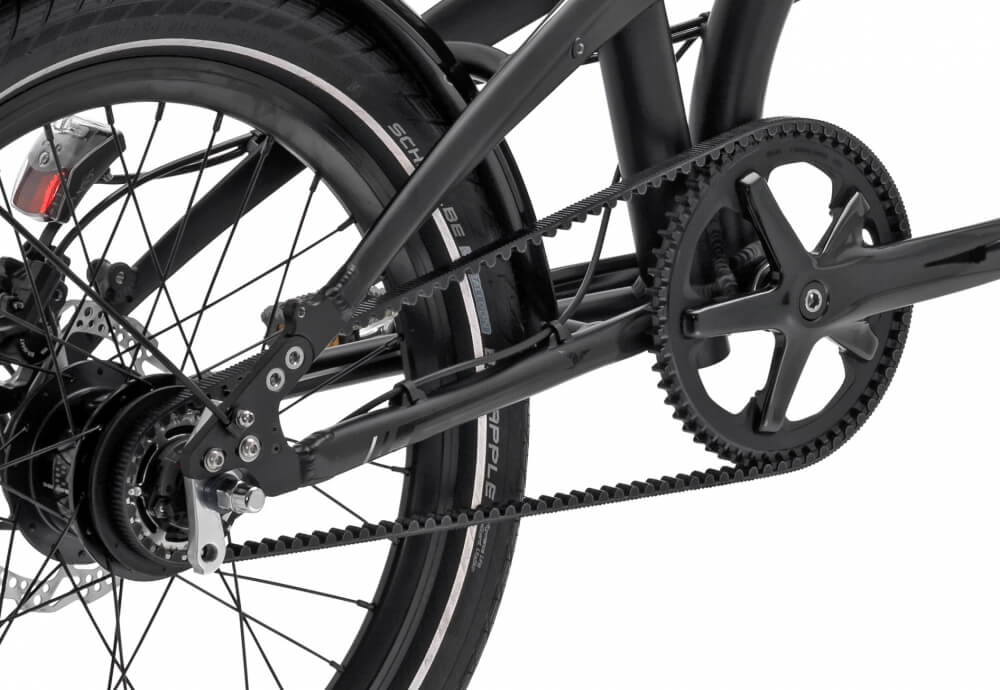Autumn Gear Guide
Find inspiration in our Gear Guide that will keep you out on your bike through wind or rain.
Download NowThe wonders of a belt drive.

Photo courtesy of Tern
Cyclists have had a love/ hate relationship with chains since the first chain-driven bicycle rolled off the line in 1874. Simple in their design, inexpensive to replace and easy to diagnose, chains are also dirty, heavy and not particularly robust in the urban setting. Frequent hard-acceleration, varying pedal pressure, track stands and a myriad of automotive-grade grime are all part of the daily grind that can cripple a chain. Quite simply, city bikes take a lot of abuse from the road, yet need to perform reliably. Enter the belt drive.
Made out of polyurethane, carbon belt drives don’t require lube, making them a cleaner option. They are also lighter, quieter and more durable than a chain. Gates invented the automotive V-belt in 1917 and subsequently has the industry know-how to ensure that bicycle belt drive technology is more than a flash in the pan.
According to Gates spokesperson, Paul Tolme, “Paired with today’s wide-range internally geared hubs, belt drives have produced a super low-maintenance commuter bike.” Portland’s Joe Bike takes advantage of Gates’ carbon-reinforced belt on the shop’s premiere front box utility bike, the Shuttlebug, where the belt’s increased durability boosts rider confidence.
While the advantages are many, there are challenges, too. Belt drives only work on bikes with internally-geared, fixed gear and single-speed hubs, as they cannot be used with derailleurs.A belt drive requires an opening in the frame, often positioned where the chainstay and seatstays meet at the chain-side dropout, so if you’ve already got a bike you love, upgrading might not be an option. You cannot take apart a belt, so installation is a bit trickier and you will need the right size of belt for your frame. Also, paired with an internal hub, a new belt-driven bicycle is likely to cost more than a freehub and derailleur-powered bike.
Fortunately, the rewards to urban cyclists are worth any added upfront expense. Riders can expect their bicycle’s drivetrain to have a long, trouble-free life. They offer smoother operation with less friction. And, if you get a pant leg or skirt caught in your belt drive, you are more likely to get it back intact and grease-free.
Follow Jeremy @towseyfrench
Find inspiration in our Gear Guide that will keep you out on your bike through wind or rain.
Download Now
This June, I switched to a Spot Acme for my daily commute, which is about 22 miles round trip on a wide variety of surfaces ranging from gravel roads to city streets. I’ve got to agree with Joe that after experiencing the silky smoothness of a belt, it’s tough to go back to my older chain drive bike. Combined with the Acme’s Alfine-11 hub, the bike is absolutely silent – the only sound you hear is the wind and your tires on the road.
After almost 3,000 miles, the belt looks new and has not needed re-tensioning or any other maintenance. Everyone should be aware that Gates has two different belt systems – a conventional one with side flanges on the cogs, similar to the larger motorcycle systems, and a center-drive that uses a slot in the center of the belt to keep it on. My bike uses a center drive system, which allows the cogs to be open on the sides and bottom. This design is really good at ejecting debris on the belt, and I’ve never had problems with small rocks getting wedged between the cog and the belt.
I’ve been riding for the last 40 years and it’s unlikely that I’d ever go back to a chain drive for my commuter bike. Silence, cleanliness, and non-existent maintenance are a tough combination to beat.
Will most likely wait for a used belt drive to come on Craigslist to buy one. Don’t see the benefit for a proprietary product that is coupled with other proprietary components, like disc brake, wheels, forks. That all spells added weight. There are plenty of heavy bikes on the market. Whatever happened to simplicity? An older steel frame, center pull brakes and fenders weighs less than these new “innovations’. The rider that hasn’t figured out how to keep their pants leg out of the chain just needs to roll up their pants. Belt drive bikes are essentially for a small group that has money to burn. The rest of us will just have to ride for the shear pleasure of riding.
Belt drives are used on motorcycles, but bikers are cautioned against riding on gravel, as stones that get lodged between the belt and the sprockets can destroy the belt. At least that’s what I’ve been told by a Harley owner with a belt drive on his motorcycle.
I bought a Strida Folding Bike with belt drive this year and I like it a lot. It is a single speed bike but you can get gears in the pedal hub like a schlumpf high speed drive. Love the look, sound and the cleanliness.
I picked up my first belt drive this spring (Raleigh Alley Way). Though, like any component, it has it’s issues, there is nothing like the buttery smoothness of a properly adjusted belt drive I’m sold and already shopping for my next one.
Comments are closed.